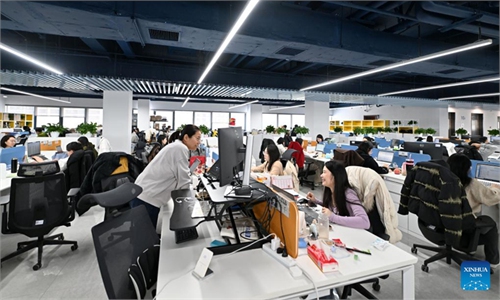
A train runs on the Beijing-Zhangjiakou high-speed railway. Photo: VCG
With an extensive historical and cultural legacy and world-class tourist destinations, the Beijing-Tianjin-Hebei region boasts a vast tourism market and cultural development, said political advisors during the ongoing two sessions. Amid the 10-year milestone of the coordinated development of the Beijing-Tianjin-Hebei region, political advisors have put forth valuable proposals for further leveraging the untapped potential of the region's cultural and tourism synergy.
One such proposal came from Zhang Kaili, a member of the Chinese People's Political Consultative Conference (CPPCC) National Committee and a nationally acclaimed actress at the National Theatre of China. Zhang suggests organizing cultural festivals in the region to advance cultural collaboration comprehensively.
She emphasized the pivotal role of culture in promoting high-quality development in the region and injecting profound connotations into economic growth. Zhang highlighted the need to harness Beijing's role as the national cultural center to integrate and amplify the unique cultural elements across the region, advancing cultural synergy and benefiting the socio-economic development of the area.
In 2014, a national strategy proposed the coordinated development of the Beijing-Tianjin-Hebei region, and since then, Beijing, Tianjin and Hebei Province have cooperated on boosting their cultural and tourism development.
Over the past decade, the region has made strides in exploring and practicing the integration and coordinated development of culture and tourism. Various cultural and tourism-themed events, such as forums on cultural tourism development, exhibitions of intangible cultural heritage, and promotions of comprehensive tourism, have been regularly organized.
To coincide with the 10th anniversary, a map of major historical and cultural resources distributed in the region was released, aiming to bring the historical landmarks "to life."
According to statistics, as of 2023, China boasts 57 UNESCO World Heritage Sites, with eight located in the Beijing-Tianjin-Hebei region. These include iconic landmarks such as the Great Wall, the Palace Museum, and the Grand Canal. The map also showcases nationally designated historical and cultural cities, towns, and villages, as well as key cultural relics protection units, totaling 474 in the region, Xinhua News Agency reported.
In light of this milestone, Yang Shuang, a member of the CPPCC National Committee and vice dean of the School of Medicine, Nankai University, suggested the establishment and utilization of the Great Wall national cultural park.
Yang emphasized the necessity of developing integrated solutions through educational tourism products and cultivating highly specialized aesthetic education researchers focused on the Great Wall, including the section of Badaling Great Wall in Beijing, the section of Huangyaguan Great Wall in Tianjin and the section of Shanhaiguan Great Wall in Hebei, urging coordinated efforts among the provinces and cities along the Great Wall to promote cultural education and tourism.

Tourists enjoy the scenery at the Shanhaiguan Pass, the eastern terminal of the Great Wall, in Hebei Province. Photo: VCG
Convenient travelLocal media reported that in late 2023, representatives from the region co-signed an agreement on "One-card Resident Services of Beijing-Tianjin-Hebei Social Security Card" that would allow the residents of the region to access services across sectors ranging from transportation to cultural tourism within the region.
Big data passenger flow monitored by the China Tourism Academy (Data Center of the Ministry of Culture and Tourism) shows that in 2023, Beijing, Tianjin and Hebei have become each other's most important and popular tourist destinations, Xinhua News Agency reported.
A Tianjin citizen surnamed Liu often drives to Hebei with his family during holidays. He told the Global Times that in summer, he would drive four or five hours to the Bashang grassland located in Fengning Manchu Autonomous County, Hebei Province, while in winter he would visit Gu'an county in Hebei enjoying the hot springs due to convenient transportation and competitive price.
Since the opening of Universal Beijing Resort, it has quickly become a popular tourist destination across the country. The number of tourists from Tianjin and Hebei has increased significantly.
Han Rui, a 23-year-old graduate from Tianjin, took her 13-year-old brother to the resort during the Spring Festival holidays. She told the Global Times with the high-speed train, traveling to Beijing is far more convenient.
Judith Yu, a member of the CPPCC National Committee and Chairman of Hong Kong Chamber of Commerce in China, believes Beijing-Tianjin-Hebei region and Guangdong-Hong Kong-Macao Greater Bay Area are highly complementary in terms of geographical location, economic scale, history and culture, and tourism resources. They can integrate their respective advantageous resources and jointly promote the upgrading of tourism consumption through the sharing of resource elements.
She pointed out that the north-south tourism has become an innovative move in the surging cultural tourism market since last year, and thus recommended that all cities in the Beijing-Tianjin-Hebei region be included in the Hong Kong and Macao special administrative regions' (SARs) free travel plan to make it more convenient for "people traveling from the north to the south." For example, the two urban areas can add special routes in flights and high-speed rail to attract consumer groups from each other.
In terms of the international market, she suggested that both sides promote traditional Chinese culture and intangible cultural heritage as key places to visit. There are a large number of high-quality national intangible cultural heritages in Beijing, Tianjin and Hebei, and they can take advantage of the international location policies of Hong Kong and Macao SARs to create important consumer categories for overseas markets.




